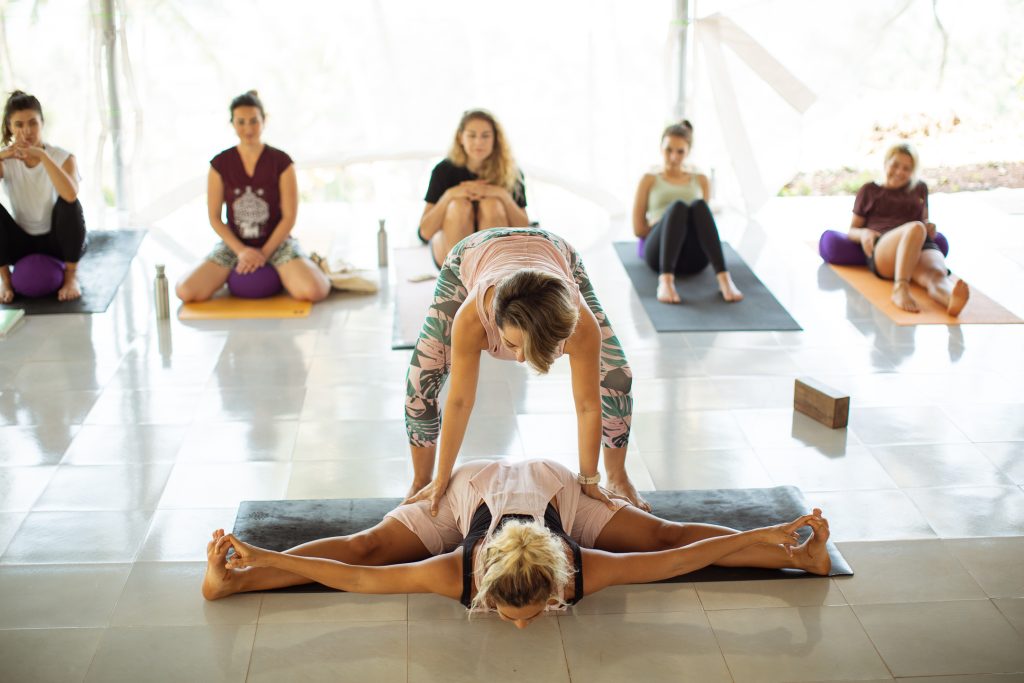Importance of Yoga Anatomy to Teach Yoga Safely
Adduction, abduction, flexion…are these familiar terms? Or perhaps strange concepts that sound too complicated? We feel you. Yoga anatomy can be a fearful and confusing subject for many teachers. But yoga anatomy for safer yoga practice is critical and can set you apart as a teacher. It will enable you to provide a safe space for your students to learn and progress. Lack of anatomy knowledge can lead to injuries, near-to-no progress in a student’s journey and a bad reputation as a yoga asana teacher.
When you learn yoga anatomy – specially with a functional approach – you understand how yoga postures are meant to feel and how each body part is impacted – including muscles, bones, joints and connective tissues – in a posture. You will be able to complement yoga philosophy with modern science.

Here are five key reasons for the importance of yoga anatomy to teach yoga safely.
- Everybody’s anatomy is different: Every individual’s body differs. Some might have a longer upper body and shorter legs, or vice-versa. Other differences could lie in the length of arms, legs, neck, or even how broad or narrow one’s shoulders are, among others. These differences change the proportion of one’s body and are aspects that impact how one performs a yoga posture and their final alignment. For example, let’s take two people who are the same height. One of them has a short torso and longer legs, while the other has a longer torso and shorter legs. When the first person does the Seated Forward Bend Pose, their forehead might reach up to the knees. For the second person, who has a longer torso, the forehead will reach well-below the knees.
Another example is understanding muscle bulk and how it can alter movement. A person with muscular thighs will find it harder to intertwine the legs together in the Eagle Pose or tuck the legs in the right way in the Half Lord of the Fishes Pose. On the other hand, a person with long and slender legs will be able to do these postures effortlessly. As a yoga teacher, identifying these differences and applying this understanding to your instructions is very helpful to safely practicing postures and mapping your student’s progress.
Read this article on ‘How Can Yoga Teachers Benefit from Knowing Yoga Anatomy’.
- Knowing the human body: Knowing how the human body is built and structured helps provide the right information to your students. The skeletal system, for example, is made up of approximately 206 bones, and these bones have an integral role in supporting the muscles and movements. Knowing the major names of the bones makes understanding the movements much easier and communicating the same to students. Imagine how much easier it would be to explain to students how their hip mobility would improve over time if you understood what a ball-and-socket joint is and how it functions. Or, the spine, for example, has four parts – the cervical (neck), thoracic (upper back), lumbar (lower back), and the sacral portion. When you are doing a backbend in yoga, you might feel the effect on the lumbar spine, but all four regions have to work together to produce the required movement. One cannot function without the other.
- Spine safety: The spine is one of the most important parts of the human body, especially when it comes to movement. Treating it with care and respect goes a long way in injury-prevention. It forms a protective tunnel for the spinal cord, and consists of a bundle of nerves that connect the spinal cord (thereby sending messages) to the rest of the body. Practitioners must be aware and the only way for them to know how and what to be aware of is if you provide the right information, guide them and educate them.. Forcing too much movement through the spinal joints can lead to nerve-injuries or swelling, numbness and tingling.
A yoga anatomy course will help you understand the importance of the spine and its safety in great detail. You will learn how the spine is connected to different parts and the impact it can have. For example, why is pressure in the hips caused due to a swelling in the lower back nerve or how does a particular posture affect the Sciatic nerve, causing pain or relief to the practitioner?
Furthermore, everybody’s anatomy is different. Let’s take the spinal curve as an example. The spine forms a natural curve from the neck that continues into the pelvis. This curve is integral to balance, weight distribution and an upright posture. The curve varies in all individuals. When doing the Headstand, for example, balance and weight distribution based on the curve will determine how straight the alignment is. Very often, because of poor posture, the curve is affected. When instructing your students, there is no need to try to correct the curve. If it is affecting practice and progress, advise them to get a medical opinion.
Forcing too much flexibility can hamper one’s progress or even set them back. As a teacher, understanding their anatomical limits and construct is important to guiding them in the right way.
- Joints, muscles and fascia: Important supporting players to each other are the joints, muscles and fascia. There are different types of joints such as hinge, pivot, saddle, etc. These joints are held together by connective tissue like fascia, tendons and ligaments. Each type of joint allows for various movements. When doing yoga postures, it is important to note that joints should only move in the direction that they are designed to move. Trying to force movements will cause injuries. Joints can also be in a slightly different shape in different people. This determines range of movement, and that some might have a greater range of movement than others. Stretching them beyond their limits can lead to wear and tear and weakening of the ligaments. Knowing these functions of the joints is helpful in guiding students in a safe way.
There are over 600 muscles in the human body. They are either voluntary or involuntary. Some muscles can cross more than one joint, cause movement in more than one direction (bending, rotating, extending, etc.), and some can even work together to produce a desired movement. In yoga, during a posture, very often multiple movements are taking place at the same joint, at the same time. Explaining these movements and how they impact a posture will help students be aware of what is happening, safety and progress.
The fascia is also an important part of the human body. It binds the body together. The more hydrated the fascia (movement provides hydration), the better the flexibility and mobility. During a stretch, if one area is tight, another can be impacted (think of the shoulders impacting the core in the plank pose). Keeping the fascia healthy and strong is beneficial to the body in the long run.
Here is an in-depth article on ‘What is Fascia and the Benefits of Fascia Release’
- Awareness of alignment: Being aware of a posture and how it feels helps practitioners go beyond their limits in a healthy and safe way. Explaining and providing an understanding of this comes from you as the teacher. Answering questions like where does the tightness lie, what necessary adjustments are needed and how to use props to enhance a posture becomes possible. With corrections, when needed, injury-risk also reduces and benefits increase.
Concluding Thoughts
Knowing and understanding yoga anatomy can help your yoga career grow in a significant way. It will help you understand the structure of movement and provide the right cues and the appropriate modifications when needed for a safe practice. When learning, try not to get overwhelmed by the knowledge. Take it slow, learn one part at a time. Try to apply that knowledge to different postures. Pay attention to the anatomy and the mechanics of that posture. When you begin to experience this, your understanding and confidence in explaining to students will improve.
Contact us if you are interested in learning more about the functional anatomy and discover how it can make you a better yoga teacher. At Sampoorna Yoga Online Academy, you will find specialized help focusing on your well-being and expanding your knowledge of yoga, no matter where you are.


